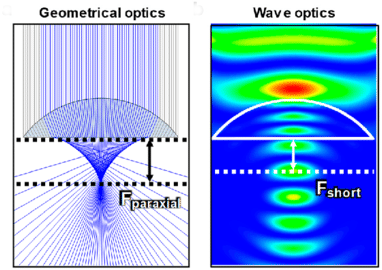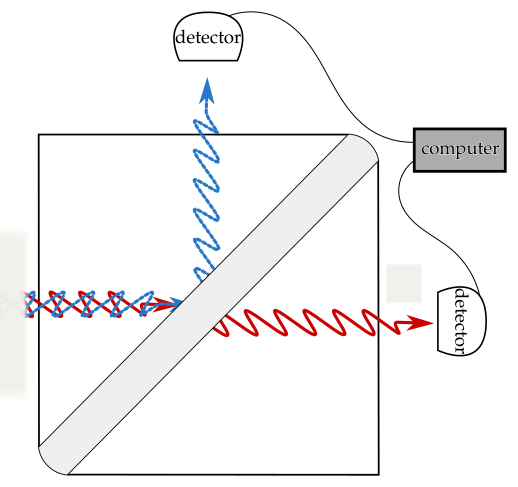Quantum Information Geometry
Konrad Szymański
RCQI Bratislava
Quantum mechanics primer

Lee, G. J. et al., Micromachines 2020.
- Einstein: light is photons — 'wave components', each with definite energy and wavelength.
- de Broglie: … maybe electrons are similar? (yes!)
-
Schrödinger: insight from the limit
wave optics \(\rightarrow\) ray optics, `electron wave' described by \(\ket{\psi(t)}=\psi(x,y,z,t)\), \[i \frac{\partial \ket{\psi}}{\partial t} \!=\! \overbrace{\left(\!-(\partial^2_x\!+\!\partial^2_y\!+\!\partial^2_z)\!+\!\frac{k}{\sqrt{x^2\!+\!y^2\!+\!z^2}}\!\right)}^{\hat H} \ket{\psi}\] - Quantum information: restricted linear subspaces of $\ket{\psi}$:\[\ket{\psi} = c_1 \ket{\psi_1} +\ldots+c_d \ket{\psi_d}.\]
What is measurement?

- Separate the parts $\cred \ket{\psi_1}\cblack, \ldots, \cblue\ket{\psi_d}$ in space: clear interpretation!
- Born interpretation: probability \(\propto~\)norm\(^2=\lvert {\corange c_k}\rvert^2\) .
- We don't know the details!
What is measurement?
- From experiment: frequencies of measurement, $P_k\approx\frac{n_k}{\sum_j n_j}$, from Born rule $P_k= \lvert c_k \rvert^2 \cgray = \lvert \langle \psi \vert \psi_k\rangle \rvert^2.$
- $P_k$ corresponds to a number $\lambda_k$: weighted average of numbers, expectation value
\[\langle \hat A \rangle = \sum \lambda_k P_k.\]
e.g. $\vec\lambda=(-1,0,1)$, $\vec P=(\frac12,0,\frac12) \implies \langle \hat A\rangle=0$
- With \(\hat A=\sum \lambda_k \ket{\psi_k}\bra{\psi_k},\) (\(\hat A\) Hermitian, real eigenvalues) \[\langle \hat A\rangle = \braket{\psi\vert \hat A\vert\psi} \color{gray}= \sum_{i,j=1}^d \psi_i^* A_{i,j} \psi_j.\]
State vectors are not the entire story…
…when information is incomplete.
What if the black box generates \(\ket{\psi_k}\) according to the ensemble \(\{(p_k,\ket{\psi_k})\}\)?
Qubit example:
$$ \hat X = \begin{pmatrix} 0 & 1 \\ 1&0 \end{pmatrix},~ \hat Y = \begin{pmatrix} 0 & -i \\ i & 0 \end{pmatrix}, ~\hat Z=\begin{pmatrix} 1 & 0 \\ 0&-1\end{pmatrix}.$$
Mixed states are statistical averages
- Expectation value linear: \[\sum
p_k \braket{\psi_k \vert \hat A\vert \psi_k}=\operatorname{Tr} \hat A
\overbrace{\sum p_k \ket{\psi_k} \bra{\psi_k}}^{\hat \rho}\]
$\Tr \begin{pmatrix} X_{1,1}&\ldots&X_{1,d}\\\vdots&\ddots&\vdots\\X_{d,1}&\ldots&X_{d,d}\end{pmatrix}=X_{1,1}+\ldots+X_{d,d}, \Tr(\hat A\cdot \hat B\cdot \hat C)=\Tr(\hat C\cdot \hat A\cdot \hat B)$
- Qudit mixed states: \[\mathcal{M_d} =
\{ \hat \rho \in \mathbb{C}^{d\times d} : \hat \rho=\hat \rho^\dagger,
\operatorname{Tr} \hat \rho=1, \hat \rho \succeq 0\}.\]
$\hat X\succeq 0 \Leftrightarrow \hat X=\sum x_k \ket{\psi_k}\bra{\psi_k}$ with positive $x_k$.
- Natural state mixing $p \hat \rho+(1-p) \hat \rho'$, all properties defined by \(\hat \rho\). Ensemble details irrelevant.
$\mathcal{M}_2$: the Bloch ball represented by allowed $(\langle \hat X\rangle, \langle \hat Y\rangle, \langle \hat Z\rangle)$.
$\mathcal{M}_3, \mathcal{M}_4$ more complex…
Numerical ranges: projections of state space
(like a photo is a 2D projection of 3D space)
Numerical range: \[W(\hat A_1, \ldots, \hat A_n) \\= \{ (\langle \hat A_1\rangle_{\hat \rho} ,\ldots, \langle \hat A_n \rangle_{\hat \rho}) : \hat \rho \in \mathcal{M} \}\]
\(\hat A_i\) Hermitian: \[\langle \hat A\rangle_{\hat \rho} = \Tr \hat A \hat \rho,\] with $\hat A=\sum_{k=1}^d \lambda_k \ket{\psi_k} \bra{\psi_k}.$
$W(X)$: all possible expectation values
$$W(\hat X)=[\lambda_{\min}(\hat X),\lambda_{\max}(\hat X)]$$$W(\hat X_1, \hat X_2)$: all possible tuples of expectation values
$W(\hat X_1, \hat X_2, \hat X_3)$: triples

Numerical ranges geometry is defined by polynomials
$\sim$ max. root of characteristic polynomial $\det(\hat X-\lambda \hat \I)$
$\sim$ max. root of characteristic polynomial $\det(n_1 \hat X_1+n_2 \hat X_2-\lambda \hat \I)$
Polynomial theory!
Uncertainty relations
- Variance: from observation statistics (outcome $\lambda_k$ of $\hat A$ with probability $P_k$), \[\operatorname{Var}(\hat A)=\langle (\hat A-\langle \hat A\rangle)^2\rangle=\braket{ \hat A^2}-(\braket{\hat A})^2.\]
- Given two measurements $\hat A$ and $\hat B$, what is the relation between variances?
- The Heisenberg uncertainty relation: \[\operatorname{Var}({\cred\hat x}) \operatorname{Var}({\cblue\hat p}) \ge \frac{\hbar^2}4,\text{~~for~~}({\cred\hat x} {\psi})\cblack(x)=\cred x\cblack\cdot {\psi}(x)\cblack, ({\cblue\hat p} {\psi})(x) = \cblue-i\hbar\left.\frac{\partial}{\partial x}\cblack{\psi}\right|_{x}\]
Sum of variances: 3D joint numerical range
Goal: Precise magnetic field $B$ measurement ($SU(2)$ metrology)
(Magnetic field changes atoms' properties $\hat X$ and $\hat Y.$ They are measured, and $B$ is reconstructed)
Precision of $B$ bound by variances, $$ \Delta^2(B) \le \text{const.}\times({\operatorname{Var}(\hat X) +\operatorname{Var}(\hat Y)}),$$ for specific $\hat X$ and $\hat Y$.Observation: minimal sum on variances
on the surface of \(\cred W(\hat X,\hat Y,\hat X^2+\hat Y^2)\).
Tangent
to the paraboloid.
Result: polynomial in $\lambda$, minimal root$\sim$minimal sum of variances.
Summary
- Different definition of sets of quantum states help in some cases.
- Numerical ranges (possible tuples of expectation values) are their projections, with polynomial theory connection.
- Uncertainty relations for accurate measurements can be determined this way.
Thank you for your attention!
- K.S., Numerical ranges and geometry in quantum information: Entanglement, uncertainty relations, phase transitions, and state interconversion (PhD thesis), arXiv: 2303.07390,
- K.S., S. Weis, K. Życzkowski, Classification of joint numerical ranges of three hermitian matrices of size three, LAA 2018,
- T. Simnacher, J. Czartowski, K.S., K. Życzkowski, Confident entanglement detection via the separable numerical range, PRA 2021,
- K.S., K. Życzkowski, Geometric and algebraic origins of additive uncertainty relations, J Phys A 2019,
- Lee, G. J. et al., Micromachines 2020.
- J. Xie et al., PRL 2020
References:
Correlation between different parts of the system
- State of two systems: \(\rho\in
\mathcal{M}_{d_1\times d_2}\)
(\(\rho=\) convex combination of projectors onto subspaces in \(\mathcal{H}_{d_1}\otimes\mathcal{H}_{d_2} \))
- No correlation at all: \(\rho = \rho' \otimes \rho''\)
- Any non-tensor \(\rho\): correlation when measuring two subsystems!
- Definition (separable states of bipartite \(\mathcal{H}_{d_1}\otimes\mathcal{H}_{d_2}\)): \[ \mathcal{M}^{\text{sep}}_{d_1,d_2} = \operatorname{conv}\{ \Pi_{\ket{v_k'}}\otimes \Pi_{\ket{v_k''}}: \ket{v'}\in\mathcal{H}_{d_1}, \ket{v''}\in\mathcal{H}_{d_2}\} \]
- \(\mathcal{M}^{\text{sep}}_{d_1,d_2}\) allows for
correlations… but not all of them!
\(\mathcal{M}^{\text{sep}}_{d_1,d_2}\) is a proper convex subset of \(\mathcal{M}_{d_1\times d_2}\).
Entanglement and separable numerical ranges
Joint numerical range vs separable numerical range
- \(W_{\text{sep}}=\{\vec a \in \mathbb{R}^n | a_i = \operatorname{Tr} \rho A_i, \rho \in \mathcal{M}^{\text{sep}}\}\)
- Expectation values outside \(W_{\text{sep}}~\implies\) entanglement!
- \(W_{\text{sep}}\) convex \(\implies\) defined by linear constraints.
- Approximation by half-space intersection in
general NP-hard!
S. Friedland, L-H. Lim, Nuclear Norm of Higher-Order Tensors, Math. Comp. 2014
Entanglement and separable numerical ranges
Goal: maximize \(\operatorname{Tr} X(\rho'\otimes \rho'')\) over \( \rho'\in\mathcal{M}_2, \rho''\in\mathcal{M}_d \).
Lemma:
Optimization reduces to finding a point on the surface
of 4D joint numerical range, tangent to a
hypercone.
Main points:
- \( \operatorname{Tr} X (\rho'\otimes \rho'')=\operatorname{Tr} \rho' X''\), where \[X''=\operatorname{Tr}_2 X (\operatorname{Id} \otimes \rho'')\]
- For \(\rho''\) fixed, \[\max_{\rho'} \operatorname{Tr} \rho' X'' = \lambda_{\max}(X'').\]
- \(X'' \in M_{2\times 2} \implies \) for \(X_i=\operatorname{Tr}_1 X(\sigma_i\otimes \operatorname{Id})\), \[\lambda_{\max}(X'')=x_0+\sqrt{x_1^2+x_2^2+x_3^2}\]
- Linearization possible: then semidefinite programming.